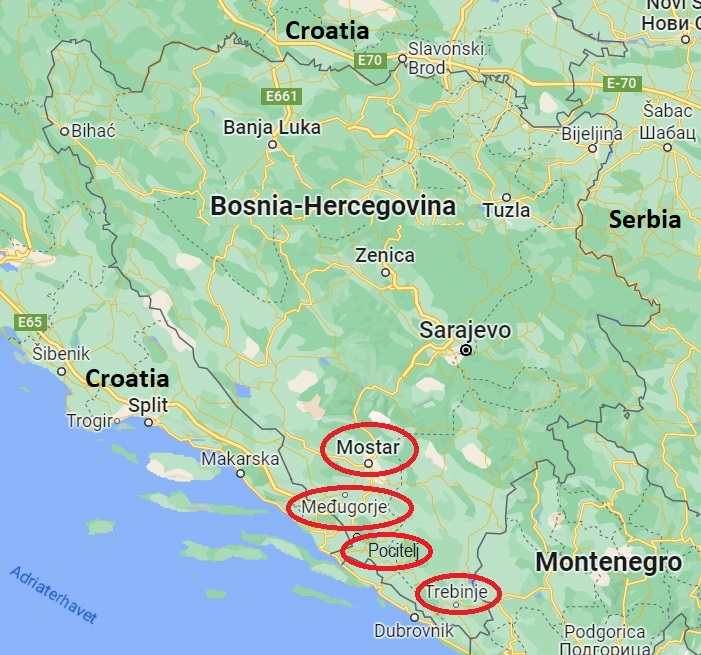
Bosnia-Hercegovina
Bosnia and Herzegovina borders Serbia to the east, Montenegro to the southeast, and Croatia to the north and southwest. In the south it has a narrow coast on the Adriatic Sea within the Mediterranean, which is about 20 kilometers long and surrounds the town of Neum. Sarajevo is the capital and the largest city of the country. Population is about 3.3 million. The country is home to three main ethnic groups, designated “constituent peoples” in the country’s constitution. The Bosniaks are the largest group of the three, the Serbs are the second-largest, and the Croats are the third-largest. Minorities, who under the constitution are categorized as “others”, include Jews, Roma, Albanians, Montenegrins, Ukrainians and Turks.
Bosnia, which is the inland region of the country, has a moderate continental climate with hot summers and cold, snowy winters. In the central and eastern regions of the country, the geography is mountainous, in the northwest it is moderately hilly, and in the northeast it is predominantly flat.
Herzegovina, which is the smaller, southern region of the country, has a Mediterranean climate and is mostly mountainous. The highest point of the country is the peak of Maglić at 2,386 meters, on the Montenegrin border.
I visited Bosnia-Hercegovina on a tour in March-April 2023. (See the full movie here).
Medjugorje, 31. March 2023
Medjugorje, one of the world’s most famous Catholic pilgrimage sites, is a town located in southwestern Bosnia and Herzegovina, about 25 km southwest of Mostar and 20 km east of the border with Croatia. The town is part of the Citluk municipality and geographically part of Hercegovina. Since 1981, it has become a popular site of Catholic pilgrimage due to Our Lady of Medjugorje, a purported series of apparitions of Mary, mother of Jesus, to six local children that are supposedly still happening to this day.
We had an hour stop here to see the church before driving to Mostar. In the evening we stayed overnight in a hotel in Medjugorje.
Mostar, 31. March 2023
Mostar is situated on the Neretva River and is the fifth-largest city in the country. It was named after the bridge keepers (mostari) who in the medieval times guarded the Stari Most (Old Bridge) over the Neretva river. The Old Bridge, a UNESCO World Heritage Site, built by the Ottomans in the 16th century, is one of Bosnia and Herzegovina’s most visited landmarks, and is considered an exemplary piece of Islamic architecture in the Balkans.
On 9 November 1993 the bridge collapsed due to shelling in the Yugoslav civil war. A project was set in motion to reconstruct it, and the rebuilt bridge opened on 23 July 2004.
This video is from my walk through the old city and across the famous bridge.
Pocitelj, 1. april 2023
Počitelj is a fortified settlement and a historic village near the town of Capljina. Its walled nucleus is a protected National Monument of Bosnia and Herzegovina and an open-air museum.
In the period between 1463 and 1471 the town housed a Hungarian garrison and was fortified into a strategic defense stronghold. In 1471, following a brief siege, the town was conquered by the Ottomans, and remained within the Ottoman Empire until 1878. From 1782 to 1879 Počitelj was under the jurisdiction of judge, and the center of the Počitelj military district from 1713 to 1835. After the establishment of Austro-Hungarian rule, Počitelj lost its strategic importance and started deteriorating rapidly.
This video is from my walk up to the viewpoints.
